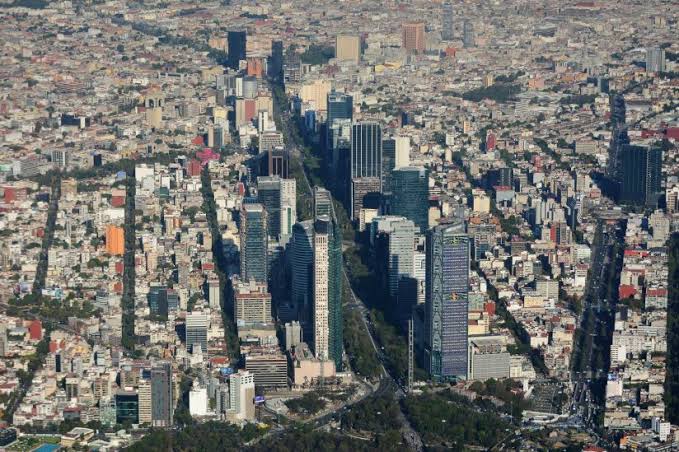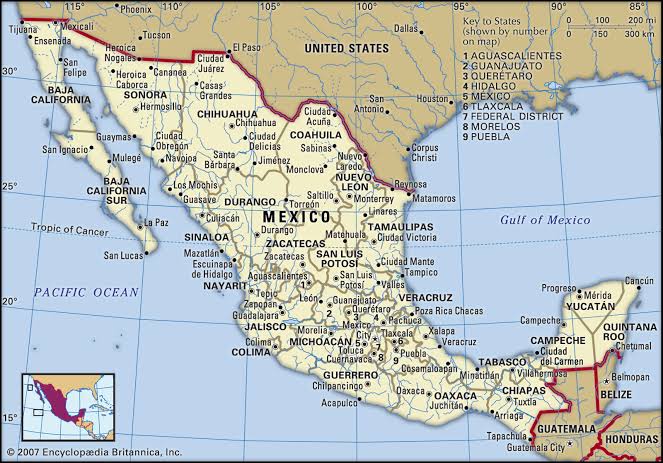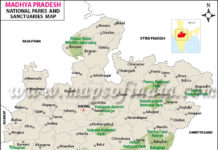Facts In Brief About Mexico
- Area : 1,964,382 Sq. Km.
- Population : 12.76 crores (2019)
- Capital : Mexico City
- Currency : Mexican Peso
- Religions : Christianity
- Languages : Spanish
- Government : Federal Republic
- Per Capita Income : 19,990 PPP dollars (2019)
Mexico’s flag

Mexico’s flag adopted in 1821, features a version of the countrie’s coat of arms. The green stand for independence, white for religion, and red for Union.
The coat of arms represent a legend which says the Aztec Indians build their capital Tenochtitlan (Now Mexico city) where they saw an eagle perched on a cactus and devouring a snake.
Officially United Mexican States.
It is northernmost and the third largest country of Latin America. Situated in the southwestern part of mainland North America and roughly triangular in shape, Mexico stretches more than 1,850 miles from northwest to southeast.
It’s width varies from more than 1,200 miles in the north to less than 135 miles at the Isthmus of Tehuantepec in the south.
Mexico is bordered by the United States to the north, Belize and Guatemala to the southeast, the gulf of Mexico and the Caribbean Sea to the east, and the Pacific ocean to the south and West.
The capital, Mexico city, is one of the largest cities in the world. Area 758,452 square miles.
Much of the northern part of the state lies in the value of Mexico, or Anahuac, a circular lecustrine plain and intermontane basing from which most of the lekes have disappeared, leaving only swamps, sodden meadows, and lagoons.
Mexico has a vast wealth of mineral resources, a limited amount of agricultural land, and a rapidly growing population.
More than half of the people live in the central core, while vast areas of the arid north and the tropical South are sparsely settled.
Petroleum and tourism have come to dominate the economy and industrialisation is increasing in many part of the country.
Mexico is rich in minerals it is the leading producer of silver in the world. The country also has a large deposits of copper, gold, lead, salt and Sulphur.
Petroleum production has a long been important in Mexico. Mexico is leading producer of petroleums. It pumps more than 950 million barrels of petroleum each year.
Oil wells are found chiefly in the states of campeche, tabasco and Veracruz, along the coast and in the gulf of Mexico.
The petroleum industry is operated by a government agency.
Mexico city
Mexico City Skyline : The stately snowcapped peaks of Iztaccihuatl and Popocatepetl rice behind the modern skyline of Mexico city.

Built by the Aztecs in the 14 th century on a series of island connected by Canals, Mexico city was seized in 1521 by Spanish conquistadors, establishing Spanish rule, which in turn was ousted three centuries later.
Mexico’s City Independence Monument : Vehicle light swirl around independence monument in Mexico city. The sculpture also called El Angle, stand in the centre of the Paseo de la Reforma.

The capital’s most fashionable avenue, Reforma leads from the historic City center through the 670 hactare ground of Bosque de Chapultepec, the world’s largest metropolitan park.
Mexican Craftworkers : Manufacturing makes up an increasing proportion of the Mexican economy. While Mexico has expanded its industrial output since the 1940s, it is still produces find handmade crafts.
Woman sells handicraft on the steps of the church of Guadalupe at Puerto Vallarta in the west Central maximum state of Jalisco.
Chichen-Itza : Reclining between two enormous serpents, the Toltec Chacmool figure Waits to receive the heart of sacrificial victims in the temple of the warriors at chichen-Itza.

These well preserved ruins of the ancient Mayan City also display the influence of the Toltecs, who defeated the Maya and established a religious centre and capital here in the 10th century.





